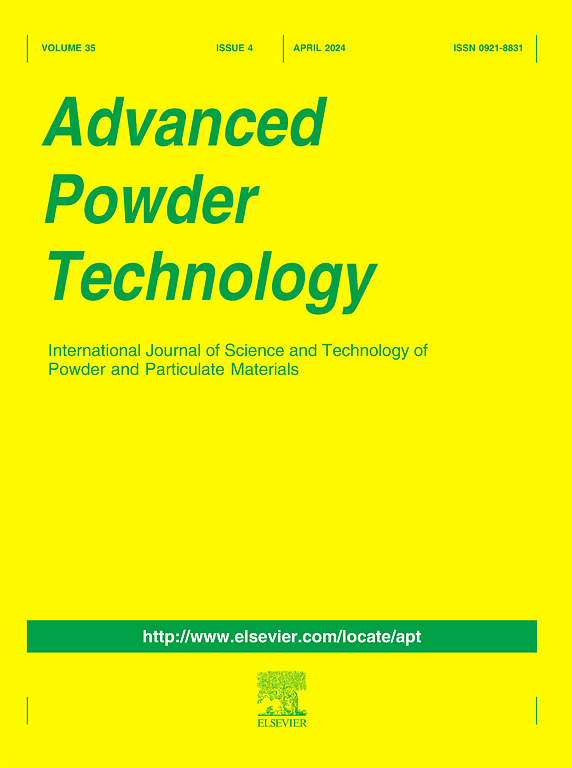Effect of ball milling on the surface chemical state of Al2O3 powders
IF 4.2
2区 工程技术
Q2 ENGINEERING, CHEMICAL
引用次数: 0
Abstract
The present study investigates the effect of ball milling on the surface chemical state of 500 nm Al2O3 powders to enable low-temperature sintering of high-performance ceramics. FTIR spectra reveal Al-OH absorption peaks. Specifically, with increasing ball milling time, the amount of stable [AlO6] groups and Al-O bonds decreases, while that of metastable [AlO4] groups and Al-O–H bonds increases, as revealed by deconvolution of XPS and Raman spectra. TEM observations confirm interparticle necking between the milled Al2O3 particles, demonstrating the enhanced surface activation. Water adsorption isotherms at 298 K demonstrate higher adsorption capacity for activated powder than raw powder, with adsorption increasing with milling time. The optimal surface activation of the 500 nm Al2O3 powder is achieved via 3 h ball milling at 600 rpm, featuring reduced particle size, increased BET surface area, and enhanced water adsorption. This mechanochemical activation enables low-temperature densification of electronic ceramics and optimization of pore structure in catalytic supports, offering a novel strategy for sustainable manufacturing of high-performance Al2O3-based ceramics.

球磨对Al2O3粉体表面化学状态的影响
本文研究了球磨对500 nm Al2O3粉末表面化学状态的影响,以实现高性能陶瓷的低温烧结。FTIR光谱显示Al-OH吸收峰。具体来说,随着球磨时间的增加,稳定[AlO6]基团和Al-O键的数量减少,而亚稳[AlO4]基团和Al-O - h键的数量增加,XPS和拉曼光谱的反卷积表明。TEM观察证实了磨后Al2O3颗粒间的颈缩现象,表明表面活化增强。298 K时的吸附等温线表明,活性粉的吸附量高于原料粉,吸附量随磨矿时间的增加而增加。500 nm Al2O3粉末的最佳表面活化是在600转/分的转速下进行3小时的球磨,其颗粒尺寸减小,BET表面积增加,吸水能力增强。这种机械化学活化可以实现电子陶瓷的低温致密化和催化支架孔隙结构的优化,为高性能al2o3基陶瓷的可持续制造提供了一种新的策略。
本文章由计算机程序翻译,如有差异,请以英文原文为准。
求助全文
约1分钟内获得全文
求助全文
来源期刊

Advanced Powder Technology
工程技术-工程:化工
CiteScore
9.50
自引率
7.70%
发文量
424
审稿时长
55 days
期刊介绍:
The aim of Advanced Powder Technology is to meet the demand for an international journal that integrates all aspects of science and technology research on powder and particulate materials. The journal fulfills this purpose by publishing original research papers, rapid communications, reviews, and translated articles by prominent researchers worldwide.
The editorial work of Advanced Powder Technology, which was founded as the International Journal of the Society of Powder Technology, Japan, is now shared by distinguished board members, who operate in a unique framework designed to respond to the increasing global demand for articles on not only powder and particles, but also on various materials produced from them.
Advanced Powder Technology covers various areas, but a discussion of powder and particles is required in articles. Topics include: Production of powder and particulate materials in gases and liquids(nanoparticles, fine ceramics, pharmaceuticals, novel functional materials, etc.); Aerosol and colloidal processing; Powder and particle characterization; Dynamics and phenomena; Calculation and simulation (CFD, DEM, Monte Carlo method, population balance, etc.); Measurement and control of powder processes; Particle modification; Comminution; Powder handling and operations (storage, transport, granulation, separation, fluidization, etc.)
 求助内容:
求助内容: 应助结果提醒方式:
应助结果提醒方式:


